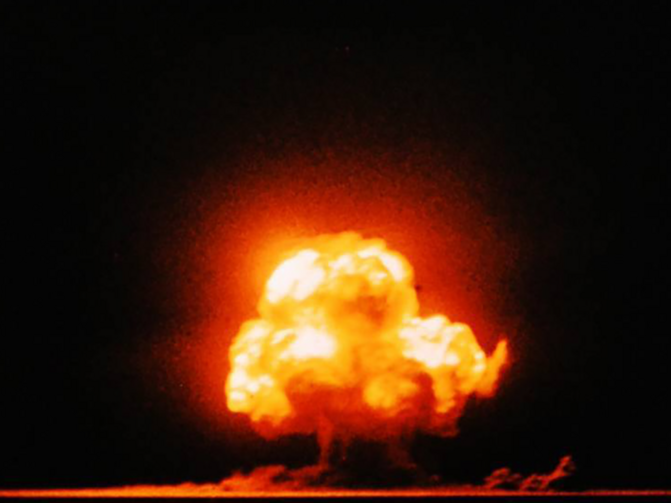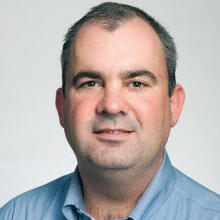“Now I am become death, the destroyer of worlds.”
J. Robert Oppenheimer recalled saying these words after the detonation of the first atomic bomb in Los Alamos, N.M., 80 years ago tomorrow, on July 16, 1945. A quote from the Bhagavad Gita, the line has come in the American context to stand for Oppenheimer’s realization of the awful power he and his fellow scientists had unleashed upon the world. Oppenheimer—who later told U.S. President Harry Truman that “there is blood on my hands”—wasn’t wrong: Eight decades is a long time to live under the threat of nuclear annihilation, particularly as the “nuclear club” of nations has grown and continues to attract aspirants year after year.
Very few people knew about the New Mexico test at the time; it was the culmination of a top-secret program (with the blasphemous name of “Trinity,” given by Oppenheimer himself after he read a John Donne poem addressed to the “three-person’d God”). Not until almost a month later did the world become aware of the dawn of the nuclear age when the United States dropped atomic weapons on Hiroshima on Aug. 6 and Nagasaki on Aug. 9, killing between 150,000 and 250,000 people.
The Vatican did not immediately condemn the twin atomic attacks: Though L’Osservatore Romano published an editorial critical of President Truman’s decision soon after Hiroshima, Pope Pius XII stopped short of an official condemnation. America’s response was similarly muted, part of a general editorial tone throughout World War II that rarely overtly criticized American military actions. On the one hand, the principles of just war clearly did not allow for the indiscriminate destruction—or even threatened destruction—of an entire city; on the other hand, the impression in 1945 was that atomic bombs would force Japan to surrender and save the world another year of war (and save the United States the loss of a million soldiers in an invasion of the Japanese home islands).
In the issue that followed the atomic attacks, however, America’s editors struck a darker tone about what nuclear weapons portended for the future of humanity. On Aug. 18, 1945, they wrote:
What defense can there be, then, against the awful forces that have now been unleashed with the utter terror of the atomic bomb? In the nightmare world that opens up on our vision, is it too much to envisage mankind underground? With our sun-lamps, our air-conditioning, our synthetic foods, it is certainly not too fantastic to see the future world, some generations hence, not walking free in God’s sunshine and air, but burrowing deeper into buried cities. In place of cathedral spires and church towers reaching to the heavens, the most familiar architecture man knows may be the catacombs and warrens of his subterranean shelters.
Over the decades since, the editors (and many other contributors to America) have revisited the United States’ reliance on nuclear deterrence, almost always in critical terms; in 2008, the editors argued that the United States should “repent of these crimes ‘against God and man’” and issue a belated “acknowledgment of wrongdoing and an apology to the Japanese people for targeting civilians.” (Don’t count on that happening, at least anytime soon.)
The Vatican, too, has become increasingly vocal in its opposition not only to the use of nuclear arms but even their possession. In his message for the World Day of Peace in 2006, Pope Benedict XVI called nuclear deterrence “not only baneful but also completely fallacious. In a nuclear war there would be no victors, only victims.” On a visit to Hiroshima and Nagasaki in 2019, Pope Francis made his position clear. “The use of atomic energy for purposes of war is immoral, just as the possession of atomic weapons is immoral,” he said. “We will be judged on this.”
On the ground in Hiroshima on the morning of Aug. 6, 1945, was a Jesuit novice master who would later become head of the Society of Jesus worldwide and a candidate for sainthood: Pedro Arrupe, S.J. Trained as a doctor, Arrupe directed what relief efforts were possible for the city’s tens of thousands of victims, and many biographers have argued that the experience indelibly changed his outlook on the relationship between Christian discipleship and questions of justice. He later called the Hiroshima bombing “a permanent experience outside of history, engraved on my memory.”
Late last month in America, Dawn Eden Goldstein wrote of Arrupe’s devotion to the Sacred Heart of Jesus and the connection with Hiroshima, noting Arrupe’s words to a group of Japanese students years later: “While the atomic energy is destined to destroy and atomize everything, in the Heart of Christ we have an invincible weapon whose power will destroy every evil and unite the minds and hearts of the whole of mankind in one central bond, his love and the love of the Father.”
The theologian Greg Hillis wrote for America in 2022 on what Thomas Merton could teach us about nuclear weaponry and the specter of nuclear war. (Greg was also a guest on America’s Jesuitical podcast in March of that year; you can listen here.) Hillis, a longtime contributor to and friend of America,who died last October, offered this reflection on Merton and the issue:
He would be heartened by the ways in which the magisteriums of our last three popes have been unambiguous in their condemnations of the use of nuclear weapons, and encouraged by the ways in which the church has moved away from just war teachings given the destructive capabilities of nuclear weapons. He would remind us as Catholics that we cannot, under any circumstances, support their use. He would tell us that we must speak out forcefully against the continued possession of nuclear weapons, that we as citizens have to make it clear to our leaders that there is no situation in which nuclear weapons of any size could be justified and that we cannot escalate any circumstance to such a degree that nuclear weapons might be considered.
Five years ago, former America editor in chief Drew Christiansen, S.J., a longtime advocate for disarmament who died in 2022, penned the following call for a nuclear-free world on the 75th anniversary of the Hiroshima bombing:
Let it be the time when Americans and Japanese—with all people of good will—rip off the veneer of legitimacy from nuclear arms and speed the day when no nation will claim its people must rely on them for defense.
•••
Our poetry selection for this week is “The Half-Life of Longing,” by Egard Orode. Readers can view all of America’s published poems here.
Members of the Catholic Book Club: We are taking a hiatus while we retool the Catholic Book Club and pick a new selection.
In this space every week, America features reviews of and literary commentary on one particular writer or group of writers (both new and old; our archives span more than a century), as well as poetry and other offerings from America Media. We hope this will give us a chance to provide you with more in-depth coverage of our literary offerings. It also allows us to alert digital subscribers to some of our online content that doesn’t make it into our newsletters.
Other recent Catholic Book Club columns:
- Anne Carr, the ‘founding mother’ of Catholic feminism in academia
- David Tracy was more than a theologian
- The priest-detectives of American fiction
- Riley Hughes, an unsung literary jack of all trades
- The history (and future) of covering conclaves
Happy reading!
James T. Keane








